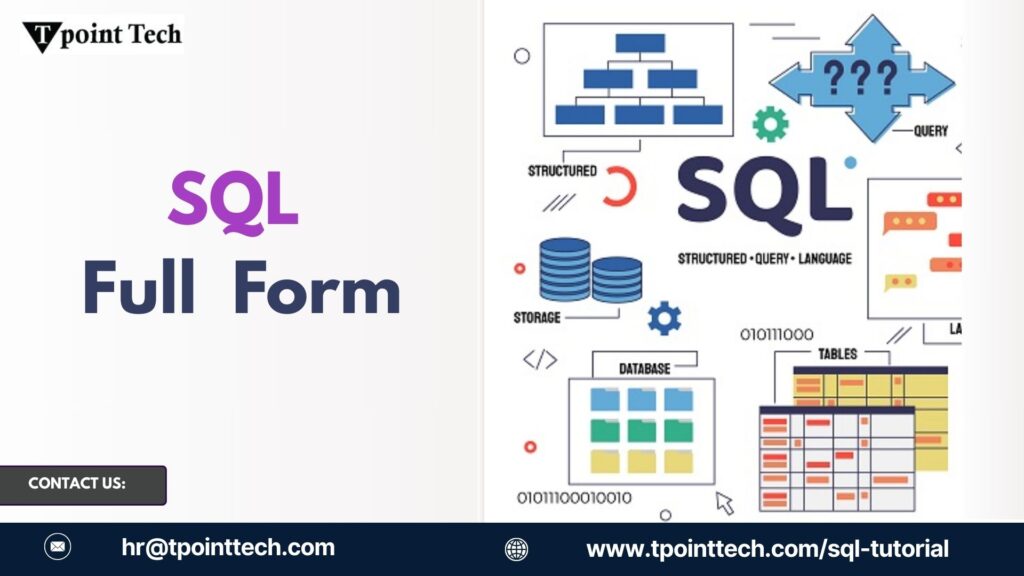SQL full form

Introduction
In today’s digital world, data is everything. Every time you search online, scroll through social media, or shop on an e-commerce site, data is being stored, retrieved, and analyzed. Behind much of this functionality is a powerful language known as SQL. If you’re a beginner looking to understand the SQL full form, its purpose, and how it works, this SQL tutorial is the perfect starting point.
What Is SQL?
SQL stands for Structured Query Language. It is a standard programming language specifically designed to manage and manipulate relational databases. First developed in the 1970s by IBM researchers, SQL has since become the backbone of modern database systems like MySQL, PostgreSQL, Microsoft SQL Server, and Oracle.
The SQL full form, “Structured Query Language,” reflects its primary function — allowing users to structure queries that retrieve or manipulate data in a well-organized and logical manner.
Why Learn SQL?
Whether you’re a software developer, data analyst, student, or someone just curious about tech, SQL is a must-learn skill. Here’s why:
- Ubiquity in Technology: Almost every application that uses data relies on SQL databases in the background.
- Job Opportunities: SQL is one of the most in-demand skills in tech jobs today, including roles in data science, business intelligence, and backend development.
- Simplicity and Power: Unlike some programming languages, SQL is relatively easy to learn but incredibly powerful.
By learning SQL, you gain the ability to communicate with databases — to tell them what data you need, how to filter it, sort it, update it, or delete it.
Key Features of SQL
Before we dive deeper into this SQL tutorial, let’s take a look at some features that make SQL so popular:
- Declarative Language: You tell SQL what you want, and the system figures out how to get it.
- High Performance: SQL can handle large volumes of data efficiently.
- Portability: SQL is used across a wide variety of database systems.
- Standards-Based: SQL has been standardized by ANSI and ISO, ensuring compatibility across different platforms.
Basic SQL Commands You Should Know
This beginner-friendly SQL tutorial wouldn’t be complete without a brief introduction to the most commonly used SQL commands. These commands fall into different categories:
1. Data Query Language (DQL)
SELECT: Used to retrieve data from a database.SELECT * FROM customers;
2. Data Definition Language (DDL)
CREATE: Creates new tables or databases.ALTER: Modifies an existing table structure.DROP: Deletes tables or databases.
Example:
CREATE TABLE students (
id INT,
name VARCHAR(50),
age INT
);
3. Data Manipulation Language (DML)
INSERT: Adds new records.UPDATE: Modifies existing data.DELETE: Removes records.
Example:
INSERT INTO students (id, name, age)
VALUES (1, 'John Doe', 20);
4. Data Control Language (DCL)
GRANTandREVOKE: Manage access permissions to the database.
How Does SQL Work?
When you run an SQL command, such as SELECT * FROM users WHERE age > 18;, the database engine parses the query, optimizes it for performance, and executes it to return the desired results. You don’t need to know the details of how the data is stored — SQL takes care of it.
This abstraction is one of the main reasons SQL is so powerful and easy to use, even for beginners.
SQL in Real Life: Practical Applications
Here are some everyday uses of SQL:
- E-commerce: Retrieve a list of products that are in stock and under a certain price.
- Banking: Generate monthly statements by querying transaction records.
- Healthcare: Filter patient records based on medical conditions.
- Education: Manage student grades, attendance, and enrollment data.
Learning the SQL full form is just the first step. When you understand how to use SQL commands, you can begin to harness the true power of data.
Common SQL Syntax Rules for Beginners
As you explore further into this SQL tutorial, keep these basic rules in mind:
- SQL commands are not case-sensitive, but uppercase is commonly used for readability.
- String values should be enclosed in single quotes (
'example'). - Statements end with a semicolon (
;). - Use comments (
--for single-line or/* */for multi-line) to explain your code.
Tips for Learning SQL as a Beginner
- Practice with Sample Databases: Use sample databases like Sakila or Northwind to get hands-on experience.
- Use Online SQL Editors: Platforms like SQLFiddle, W3Schools, or Mode Analytics let you practice without installing anything.
- Start Small: Begin with simple queries before moving on to joins, subqueries, and stored procedures.
- Follow Structured Courses: There are many free and paid courses that include exercises, projects, and certificates.
Final Thoughts
The SQL full form, Structured Query Language, may sound complex at first, but it’s one of the easiest and most valuable programming languages to learn. With this foundational SQL tutorial, you now have a clear understanding of what SQL is, how it works, and why it’s essential in today’s data-driven world.
Whether you want to build websites, analyze data, or manage databases, SQL is a skill you’ll use again and again. So take the next step — start experimenting, querying, and discovering what data can do for you.
You can also read our more blogs:
Web Development with Flask (or Django): A Python-Powered Guide


